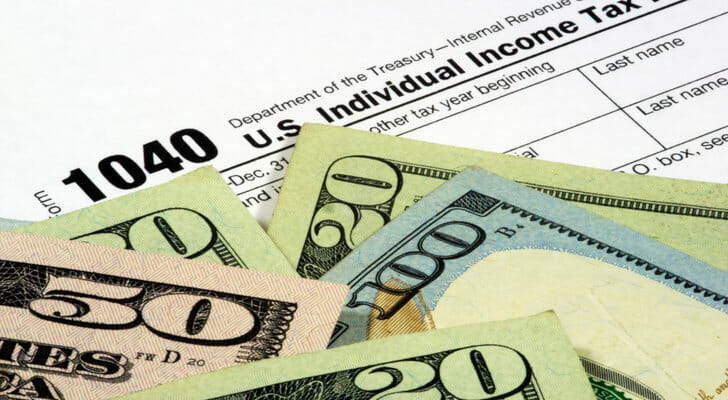An annuity’s exclusion ratio is one of the most important factors to consider when planning your investments. The exclusion ratio is the portion of an investment’s return that is not taxed. It is a percentage of the total investment payout, equal to the amount of money you originally invested. Knowing this ratio is critical to determining the after-tax income you’ll get from an annuity.
Working with a financial advisor takes the headache of dealing with the administration of your investments away and you can focus on watching your nest egg grow.
Annuity Exclusion Ratio Defined
Because the IRS only collects taxes on your profits after the initial investment cost, a portion of your income from an annuity is free from taxes. This percentage is known as the annuity exclusion ratio: the proportion of principal to return that you will see in the annuity income.
Note that to have an exclusion ratio, you must have bought your annuity with after-tax income, such as cash on hand. If you used pre-tax income, such as a tax-advantaged retirement account, then there is no exclusion ratio, and you would pay taxes on all of the income.
An annuity’s exclusion ratio is typically spread out over the annuity’s lifetime of payments. Instead of receiving a lump sum of income tax-free, each payment from the annuity has its taxable income reduced by a certain percentage.
As an example, let’s say you invested $100 in an annuity, which will ultimately pay out $200 in installments of $20 each. (This is a deeply unrealistic expectation of average annuity returns, though it will suit our purposes here.) Your exclusion ratio here would be 50%—the ratio of your principal to returns. When you receive your income from the annuity, you wouldn’t be taxed on $10 of each check as you collect back your initial investment.
Keep in mind that withdrawing money from an annuity carries some significant tax penalties, including an inversion of the exclusion ratio process. If you take money out of an annuity early, the IRS considers this money as earnings in a last-in/first-out formula. As a result, you would have to pay full taxes on the money withdrawn early until the annuity only has the initial investment left in it, at which point you could withdraw that principal tax-free.
Calculating Annuity Exclusion Ratio

The process for calculating an annuity exclusion ratio varies depending on what type of annuity you have. For a fixed-income annuity with a defined payment schedule, the exclusion ratio is relatively simple to calculate. Contracts like this will guarantee a set payment amount over a fixed period of time. The ratio of principal to income, therefore, never changes.
Lifetime and variable annuities, however, have potentially unpredictable payment schedules. In the case of variable annuities, this is due to the fact that its performance hinges on an underlying portfolio of investments. In the case of a lifetime annuity, the unpredictability arises due to the uncertain duration.
For a lifetime annuity, you calculate the exclusion ratio as you would with a standard, fixed-period annuity contract. At a certain point, however, you will have collected back the entire initial investment, at which point, the exclusion ratio will fall off and the entire income of the annuity will become taxable. This will occur on a fixed and predictable date. Given the nature of a lifetime annuity, there is uncertainty only around whether, and for how long, the investor will collect income past the expiration of the exclusion ratio.
Meanwhile, for a variable annuity, you’d calculate the exclusion ratio by dividing the initial investment over the payment period. This amount is removed from the taxable income of the segment, with anything over that amount taxed as usual.
Say, for example, you purchased a variable annuity for $100 with a payment period of 20 months. You’d calculate your exclusion ratio by dividing your initial investment by your number of payment periods, or $100 divided by 20. Each month, your exclusion ratio would be $5, and anything over that amount would be considered taxable income. If your annuity were to underperform this exclusion ratio, you could roll over the amount and declare it as a loss.
Why the Exclusion Ratio Matters for Retirement Planning
Understanding the exclusion ratio is more than just a tax exercise—it directly affects how much money you keep from your annuity payments in retirement. Because only part of each check is taxable, the ratio determines your after-tax income month to month. A higher exclusion ratio means more of your payment is treated as a return of principal, leaving less exposed to taxes. Over the life of an annuity, this difference can change how much net income you have to rely on for expenses.
The timing of when the exclusion ratio expires also matters. With lifetime annuities, you eventually recover your principal through tax-free payments. After that point, however, every dollar you receive is taxable. Retirees who live well beyond life expectancy may face a shift, where their tax bills increase later in retirement. This should be factored into long-term planning.
The exclusion ratio also comes into play when choosing between annuities purchased with pre-tax funds and those purchased with after-tax funds. Pre-tax contributions offer upfront tax breaks but result in fully taxable income later. After-tax contributions, in contrast, give you an exclusion ratio that softens the tax hit on each payment. Knowing the trade-offs can help you decide which type of annuity purchase best fits your retirement income plan.
In addition, retirees in higher tax brackets may look at how exclusion ratios interact with other sources of income, such as Social Security or retirement account withdrawals. Since annuity payments can increase taxable income, the exclusion ratio can be a tool for smoothing out liabilities across years. Planning when to buy and how to structure annuities can help reduce tax drag.
Ultimately, the exclusion ratio determines the true value of an annuity in retirement. By calculating how much income will be tax-free and how much will be taxed, you get a clearer picture of your real cash flow. This clarity can make it easier to balance annuities with other retirement income sources and ensure you have enough after-tax money to cover living costs.
Bottom Line

The annuity exclusion ratio tells you how much of your annuity returns you’ll have to pay taxes on. You don’t pay taxes on your principal, so the annuity exclusion rate is calculated by dividing your principal paid by your expected return. If you buy your annuity with pre-tax money, though—like money in a retirement savings plan—you’ll pay taxes on all of your annuity returns. Once you’ve earned back your entire principal as tax-free returns, you’ll start paying taxes on all of your annuity payments.
Tips for Saving for Retirement
- As you get ready for retirement, one of the best things you can do is start working with a financial advisor. An advisor can help you maximize your retirement savings and make sure you stay on track to retire on time. Finding the right advisor doesn’t have to be hard. SmartAsset’s free tool matches you with vetted financial advisors who serve your area, and you can have a free introductory call with your advisor matches to decide which one you feel is right for you. If you’re ready to find an advisor who can help you achieve your financial goals, get started now.
- Annuities are best as a supplement to your other retirement savings. One of the best ways to build up your retirement fund is by investing in a 401(k) and taking advantage of your employer’s 401(k) match. If your employer doesn’t offer a workplace retirement plan, consider an IRA.
Photo credit: © iStock/mapodile, © iStock/Kritchanut, © iStock/JaggedPixels
